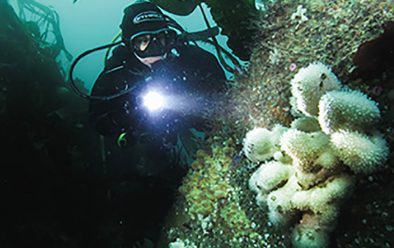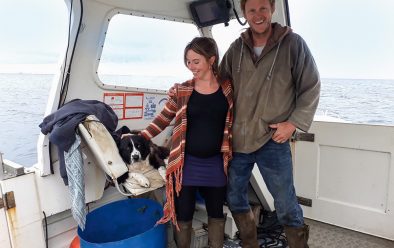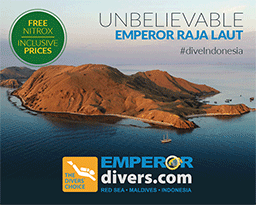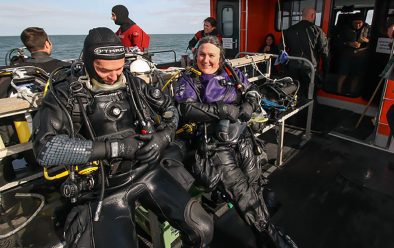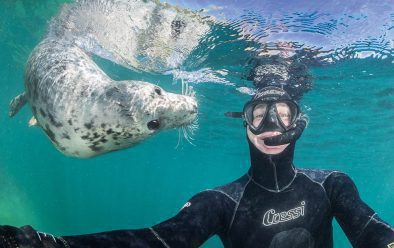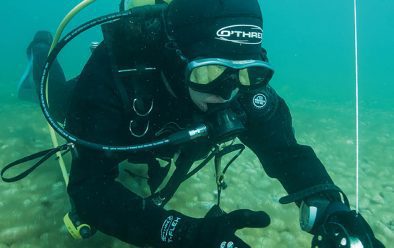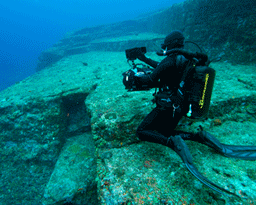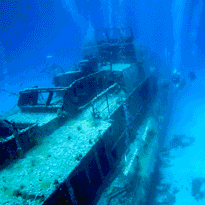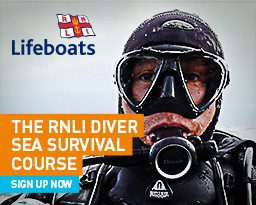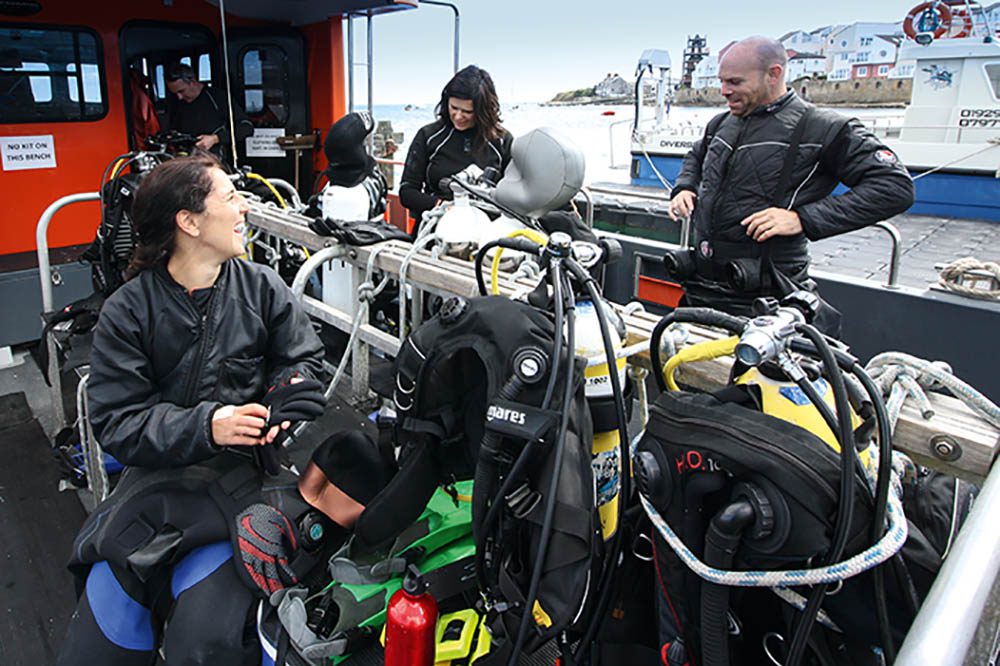
UK DIVER
Getting Started
in UK Diving
Previously WILL APPLEYARD was busy selling the joys of UK diving to any doubters out there – now, with UK diving the only practical possibility for many of us, he too gets practical

Preparing kit before ropes-off – keeping all your kit together is likely to be all the more important on boats from now on.
My diving career began in London in the early 2000s. I scoffed at the suggestion of completing the open-water part of the training in the UK (whaaat?) and took what I considered to be the softer option by completing the course in Italy.
Just weeks after my PADI Open Water Diver certification card arrived, I skipped off to join what turned out to be a disastrous Andaman Sea liveaboard trip to gain the Advanced qualification.
I completed the course, not feeling particularly “advanced” but with an escape from a sinking vessel providing added value.
A sobering experience, yes, but not one grave enough to deter me from whatever water-based adventures lay ahead.
Unwilling to wait for my next diving-holiday opportunity, I would have dived anywhere – I yearned to be in the water.
I even contacted the local golf club to see if it wanted its lake balls collected. It didn’t reply.
I’m not one for clubs, so began to scour the Internet for forums, seeking potential buddies. I fell into what was then the go-to place for armchair experts and the curious alike, UK Divers, which still appears to function as a forum today.
Some of the threads I found useful and, through the fog of diving gods, know-alls and no-mark newbies like me, found new friends who shared the same mindset.
Off we went to discover UK diving.
Appeared in DIVER August 2020
I started at the bottom of the list of available dive-sites. It hadn’t occurred to me that I could actually see things of interest while diving in the UK.
So with my eager pals we would trot off to a former naval torpedo-testing site near Portsmouth to get wet, whatever the weather and whatever the season.
Visibility was somewhere between bad and exceptionally bad, yet we would stay all day, conducting freezing dive after featureless freezing dive, just to enjoy being immersed. We kept working on those seemingly unattainable buoyancy skills, and fumbled with the fiddly art of deploying a surface marker buoy because, apparently, we’d need one.
The initial items of kit I collected were bought secondhand and I amassed a pile of trinkets I didn’t really need: a tiny, cheap torch that flooded on its first dive; a second one that did the same; a neoprene hood so small that it made me feel faint and all kinds of rattles, tank-bangers and slates.
I ordered a huge knife and acquired a 7mm wetsuit that looked to have been handed down from Jacques Cousteau himself.
That said, I still use the fins I bought all those years ago and, without wishing to tempt fate, they remain in great shape.
Eventually I worked out what I did and didn’t need to dive comfortably in the UK. I didn’t need to look like a Christmas tree, sagging with novelty tat.
I moved on to a drysuit, bought a good reliable torch, lost that and bought another, got my weighting sorted and discovered where to find genuinely interesting stuff to dive.
I realised that even a no-mark newbie like me was capable of diving in the sea without a guide and that there were wrecks to suit even my pitiful skill level.
Today, thanks to the many online platforms at our disposal, the path to knowing where to go and what to see seems shorter, the volume of information perhaps even overwhelming.
So once again to discuss the delights of UK diving, I’ve brought together a selection of divers – peers followed for their fabulous underwater imagery,
long-term diving partners, masters of the sea or all of the above – in the hope of feeding your interest.
If there was an annual award for the UK’s most enthusiastic and informative skipper, Dave Brown of Porthkerris Divers on England’s south-west coast would have a cabinet crammed with silverware.
Cornwall is a great place for the all-round diver. It’s out on a limb geographically, but it’s a pilgrimage I look forward to making most summers and a location so beautiful that it’s difficult to leave when a trip winds to a close.
Stand-out memories for Dave? His answer made me laugh: “A few years back I was taking a mixed group out on a lovely calm day. I dropped the last pair in, side-slung guys with nice, shiny gear, very much looking the part if you like that kind of thing.
“They’d dropped into the water after a considerable amount of swearing, clanging and graceful shuffling. Twenty-five minutes later, I hoisted out one of the guys on the lift, grumpy and confused.
He couldn’t figure out why his trim was out; he had an obscene amount of drag and he couldn’t keep up with his buddy.
“Slowly lifting him, I kept asking if he was missing anything, but he couldn’t figure out what was wrong. From the top of the lift I walked him over and presented him with his nice set of very dry fins that he’d left on his seat!
“The atmosphere on the boat after that between him and his buddy was awful, I couldn’t stop laughing, and funnily enough didn’t see him for the rest of the weekend!” I might have jumped into the water minus my fins before – but never to the bottom!
Much of Dave’s diving career took place in the tropics but “I always missed the Atlantic, finding it more of a challenge and having a more ‘real’ feel to it, so wound up back at Porthkerris, completing my instructor’s course and started working down there.
“The natural path was to start working on the boats, so I completed all my courses and haven’t looked back since.”
Dave fuelled my envy of his desirable location further by reminiscing about his favourite places for UK underwater exploration: “The Runnel Stone off Penzance is always an exciting place to see, likewise anywhere in the Scillies can be a joy to dive. Exploring a blip on the sounder is always exciting for me.
“Though most of the time it’ll amount to nothing, the feeling of pulling yourself down the shotline to the possibility of something new is super-exciting!
“Above all for me the area of the Manacles is always a pleasure –maybe not always so pleasant on the surface.
“The pinnacles are beautiful from the surface down to the seabed, with some nice historic wrecks to nose around in.
“Add to this the big groups of playful dolphins, bluefin tuna, minke whales and blue sharks, and you never know what you’ll see when you leave the beach.”
I can’t wait to get back down to Cornwall in the hope of sharing such experiences.
Alison Turner is a long-time UK and overseas diving partner of mine. She learnt to dive in the UK, rather than taking the soft option as I did.
“UK diving is a bit like walking in the UK. If you dress up for the conditions, take your time and look carefully, you’ll be amazed by what you see!” she says.
I concur, although some of us are way better at spotting wildlife than others.
Of course, we all learn by making mistakes. Alison learned the hard way about pre-dive checks, for example:
“I hefted my weights, BC and cylinder on, donned my fins and mask, then, with a quick check of gas, I plunged off the platform and into the cool of the water. Hmm, slightly cooler than I was expecting. And considerably wetter.
“Oh, I never got my buddy to do up my drysuit zip! It’s amazing how high you can lift out of the water just by finning when 11°C water is trickling down your spine!”
Al’s advice to newcomers is this:
“Take your time. Nothing in diving is improved by doing it quicker, especially kitting-up. You’ll use less air, see more and stay under longer by relaxing and doing things slowly.”
Taking time is also sound advice for underwater photographers. I did the opposite and took a temperamental early digital camera with me on that doomed Andaman liveaboard trip.
I soon discovered my need to master buoyancy skills first, so left the unreliable relic on the boat for the rest of the trip. I fell back into photography only once diving felt second-nature and I certainly wouldn’t get into the water without the camera now. Who knows what might pass by?
UK-based award-winning photographer Dan Bolt would agree. For some time I have followed Dan, a UK diver since 1988, on Instagram (@danboltphoto), enjoying his images taken at local dive sites.
“I had to wait 30 years before seeing my first octopus in the UK, then, like those proverbial buses, three came along all at once,” he told me. “On one night-dive last year at Babbacombe, I visited the home of a large common octopus and patiently waited for around 30 minutes, just watching him breathe and explore outside with his tentacles.
“Slowly emerging, just a metre in front of me, he wasn’t spooked by my presence, and just wandered around for a while before sloping off into the dark to go feeding. What a privilege!”
Favourite dive-site? Dan gave me three: “Firstly it would be my local site of Babbacombe in south Devon. I’ve dived here throughout my whole diving life and it never ceases to show up something new each year.
“It’s famed for the cuttlefish that come in the spring, though numbers have reduced drastically recently.
“It’s a nursery for many fish species – you can find over a dozen species of nudibranch here, as well as the odd octopus and even seahorses.
“Secondly, I’d say any of the stunning sea-lochs of western Scotland. No two are quite the same, and some go to over 100m depth just off the shore. The abundance and variety of life in these cold waters, not to mention the stunning vis at times, in my view makes this world-class diving.
“Finally, seal-diving! I’ve done this at Lundy and at the Farne Islands, and it’s by far the most fun you can have under water! Nothing puts a smile on your face like having half-a-dozen seals fighting over who gets to play with you next.”
Dan’s tip for the tentative UK diver is this: “For the past 20 years I’ve dived only with a camera, and the biggest tip I can give to anyone wanting to get the most out of their diving is to stop, look and listen. You don’t have to be a marine biologist, but a little bit of knowledge and plenty of observation will give a fascinating edge to every dive, and you can even bore your buddies with talk of nudibranchs!”
I caught up with my final peer, dive-guide Fraser Cameron and we talked about water temperatures. “Don’t worry about the cold,” he advises new UK divers. “I learned to dive in the Mediterranean and have never been colder than in those poorly fitted wetsuits.
“Appropriate exposure protection makes all the difference.”
The sea is not always what I would consider cold around the UK, especially from mid-August to September, when we can expect surface temperatures of 20*C, certainly down south. A properly fitted thick wetsuit and hood will serve you well during these months. I prefer 3mm wet gloves over the chunkier 5mm version, affording more dexterity to operate the camera, SMB and make any adjustments to kit needed under water.
From his home in Iceland, Fraser told me about his most memorable UK dive, on the ss Kintyre to the west of Glasgow.
“Climbing down the sharp rocks to get to the water I shredded both drysuit wrist-seals. This became obvious as I swam out towards the wreck, but I mistakenly pushed on. The wreck was fantastic and the colourful sponges and abundant life took my mind off the fact that my suit was filling with water.
“The problem came when I surfaced and had to haul myself and the now significantly heavier water-filled drysuit back up the same steep rocks. Lesson learnt.” Don’t try that at home, kids.
“The west coast of Scotland and the Sound of Mull in particular offer a wide range of wreck and scenic dive-sites,” said Fraser. “I enjoy trying to piece together stories of wrecks and their origins from underwater clues, and if I come across some scallops or nudibranchs along the way, all the better.”
While there are plenty of accessible shore-diving sites in the UK, many top sites are accessed by boat. When conditions are at their best, space can be at a premium aboard some UK dive-vessels. These dives can seem slightly chaotic at times, particularly with more equipment to think about than on a dive in the tropics.
Keeping it all close to you rather than spread out over the dive-deck should eliminate unnecessary stress when the skipper announces that you’re nearing the site, and it’s simply good seamanship.
Apart from a (usually) informative site briefing from your skipper, the vessel is simply your taxi. Unless you’re diving with an organised group from a club, you’re left to your own devices under water around the UK.
The skipper might ask you to tow an SMB to follow throughout a drift dive, or to deploy one on ascent. To dive without one anywhere in the world I consider unwise. Carry one even if you know how to inflate it only while at the surface for now – it’s far more visible to boat-crew then a diver’s head in a black hood.
UK wrecks are seldom marked with a permanent buoy, so your way to the surface at the end of a dive might also be by reel, line and buoy. Skippers will often put in a temporary marker, or shotline for you to descend, but it might not be left for the duration of your dive.
You will already know about the dive-site’s minimum and maximum depths when booking with the boat-charter company, but consider that a 30m dive will be a more challenging in the UK than at some of those warm, bluewater overseas sites.
Many of my favourite UK dive-sites are within 15m, with plenty of natural light. If you want to explore deeper, in more benign conditions, there are plenty of quarry dive-centres, which you can always use for learning how to deploy that SMB, too.
I would be applying too much gloss if I said that UK diving is always a scenic experience – sometimes it isn’t. I remember enduring some cold and very dark dives that I really should have thumbed back in my early diving days, and only slowly learnt when not to go diving.
But visibility can be very good and, as my peers and I have explained, there is plenty to see down there.
To enjoy UK diving to the max, be comfortable in your equipment, build up your temperate water confidence by starting shallow, and be ready for genuine adventure, without a guide and on you and your buddy’s own terms.
Find them on Instagram:
Dan Bolt @danboltphoto
Fraser Cameron @fraserhcameron
Will Appleyard @willappleyard
DIVER @diver_magazine
While locked down in Spain, WILL APPLEYARD shared dreams of UK diving through social media. So where will your first post-pandemic dive be? Click here to find out.
The post Getting Started in UK Diving appeared first on Divernet.
Read More Features, UK Diving Divernet

